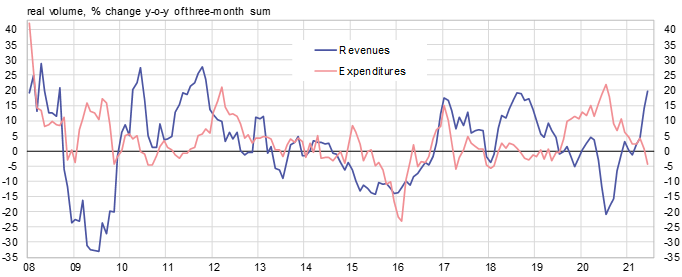BOFIT Weekly Review 33/2021
Russian government budget revenues rise, spending growth slows and budget deficit shrinks
Revenues to the consolidated budget (federal, regional and municipal budgets, plus state social fund budgets) in the second quarter of this year were up by a third from year earlier when they fell significantly. Revenues were also 17 % higher than two years ago. Real revenues of the budget have also grown as the nominal rise in revenues has considerably outpaced inflation, though inflation has also been quite high (consumer prices were up by over 9 % from two years previous, while industrial producer prices were up by about 15 %).
Budget revenues generated from production taxes and export tariffs on oil & gas sectors were up by as much as two-and-a-half times compared to the low-basis of the second quarter of 2020, largely due to the recovery in the oil export price. The oil and gas tax revenues were about the same as two years ago.
Other revenue streams to the consolidated budget also bounced back. In the second quarter they were up 20 % y-o-y (or 40 % if the spring 2020 transfer of most of the CBR’s extra surplus that arose from selling the CBR stake in Sberbank is excluded). Other budget revenues were 20 % higher than two years previous. Revenue growth from value-added taxes has been particularly robust, up by over a third from the relatively small dip in spring 2020 and 30 % from two years previous. Besides larger production and imports, VAT collection also seems to have improved further. VAT revenues now account for about a fifth of consolidated budget revenues.
Revenues from corporate profit taxes and labour income taxes recovered fast, and revenues from mandatory social contributions of employers were also up briskly. Compared to two years ago, these budget revenue categories were up about 15−20 %. In addition, high growth in various smaller budget categories considerably impacted the increase in total budget revenues.
The push to increase budget spending initiated in spring 2020 to support the economy and mitigate the social impacts of the recession has largely waned. On-year growth in spending slowed below 7 % in the second quarter, and real spending shrank slightly. Notably, spending in spring 2020 was substantial (up by nearly 20 % y-o-y). Spending growth on various sectors of the economy remained robust (up 30 % y-o-y) in the second quarter, and growth in budget spending on the housing sector remained brisk (up 15 %). Growth in spending on education accelerated (up 10 %), while spending on healthcare went into decline. Spending on public administration, defence and domestic security and law enforcement have seen only modest increases this year. Pension spending has increased just slightly, while spending on other social support tapered off when compared to the heavy spending in spring 2020.
Looking back two years, spending on the different branches of the economy has soared (up 70 %) as has spending on other social support (up 45 %). Spending on healthcare and public administration has also increased considerably (each up by 25 %). Spending on education, defence, and domestic security and law enforcement have seen more moderate gains (up by 12−16 %). Pension spending has grown by less than 10 % amidst a gradual decline in the number of pensioners and following the 2018 decision to limit the average pension increases to 6−7 % a year. Due to the increased spending levels of 2020 and 2021, it is possible that any notable spending pick-ups preceding the upcoming Duma elections next month (e.g. a brisk on-year rise in federal budget spending in July) will be short-lived.
As earlier during post-recession recovery, Russia is aimed at reducing the budget deficit that came about during the slump. The rapid rise in revenues combined with the spending restraint has pushed the consolidated budget to show notable surpluses in recent months. In June, the budget deficit for the last twelve months fell below 2 % GDP, down from nearly 4 % of GDP in March.
Real revenues to Russia’s consolidated government budget increased rapidly in recent months, while real expenditures have declined slightly from one year earlier

Sources: Russian Ministry of Finance and BOFIT.